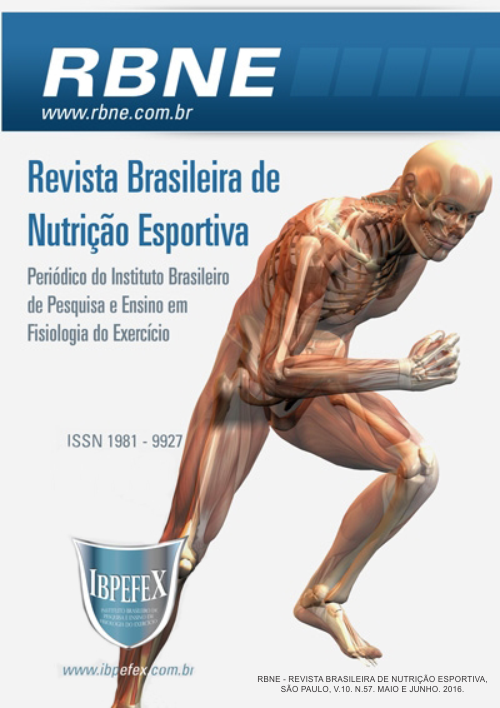Nutritional assessment and body self-perception associated with the use of supplements for bodybuilders in some towns of Serra Gaúcha
Abstract
Introduction: Gym goers have specific characteristics which differ them from other groups. Aim: The aim of this study is to describe the anthropometric profile, to analyze the food consumption, and the body self-perception associated with the use of supplements. Materials and methods: Cross-sectional study that has analyzed 127 individuals. The anthropometric data have been observed through the body mass index and the body fat percentage. The body self-perception has been analyzed through close questions and silhouettes scales. The regular practice of physical exercises and the use of supplements have been verified. The dietary intake has verified the adequacy of macronutrients and micronutrients –vitamins A, C and E, calcium, iron, selenium and zinc, calculated through the Dietwin program. For statistical analysis, the Statistical Package for Social Sciences program (SPSS), version 18.0, have been used, considering significant values of p<0.05. Results: The results have observed eutrophic anthropometric profile in 66.4% of the sample. In percentage of body fat was observed prevalence of acceptable average parameters. In the analysis of satisfaction with physical appearance, 60.6 % reported being satisfied with their body image. When verifying the scale of silhouettes, 23% of individuals see themselves eutrophic over the current look with desire for smaller silhouette, in which was observed prevalence of supplementation. Thecaloric intake was found to be low-carbohydrate, high-protein and low-fat. The intake of micronutrients was observed below the recommended vitamins (A, C and E), and calcium. Conclusion: The anthropometric profile showed a higher prevalence of normal weight. The interviewed have a low-carbohydrate, high-protein and low-fat diet, with significant inadequacy for macronutrients and micronutrients. Supplement use was found in greater proportion in individuals dissatisfied with their body image, with desire forsmaller silhouette.
References
-Alves, S. C. R.; Navarro, F. O uso de suplementos alimentares por frequentadores de academias de Potim-SP. Revista Brasileira de Nutrição Esportiva. São Paulo. Vol. 4. Núm. 20. p.139-146. 2010. Disponível em: <http://www.rbne.com.br/index.php/rbne/article/view/174/171>.
-Da Silva, P.R.P.; Czepielewski, M.A. Prevalência do Uso de Agentes Anabólicos em Praticantes de Musculação de Porto Alegre. Arq. Bras. Endocrinol Metab. Vol. 51. Núm. 1. 2007.
-De Carvalho, P.H.B.; Filgueiras, J. F.; Neves, C.M.; Coelho, F.D.; Ferreira, M.E.C. Checagem corporal, atitude alimentar inadequada e insatisfação com a imagem corporal de jovens universitários. J. Bras. Psiquiatr. Vol. 62. Núm. 2. p. 108-114. 2013.
-De Souza, M.C.D.F.P.; Souza, L.V.E.; Barroso, S.M.; Comin, F.S. Padrões alimentares e imagem corporal em mulheres frequentadoras de academia de atividade física. Psico-USF. Vol. 18. Núm. 3. p. 445-454. 2013.
-Dietary Reference Intakes. 2011. Disponível em: <http://iom.edu/Activities/Nutrition/SummaryDRIs/~/media/Files/Activity%20Files/Nutrition/DRIs/New%20Material/5DRI%20Values%20SummaryTables%2014.pdf>
-Fermino, R.C., Pezzini, M.R., Reis, R.S. Motivos para Prática de Atividade Física e Imagem Corporal em Frequentadores de Academia. Rev. Bras. Med. Esporte. Vol. 16. Núm. 1. 2010.
-Ferrari, E.P.; Petroski, E.L.; Silva, D.A.S. Prevalence of body image dissatisfaction and associated factors among physical education students. Trends Psychiatry Psychother. Vol. 35. Núm. 2. p. 119-127. 2013.
-Hirschbruch, M.D.; Fisberg, M.; Mochizuki, L. Consumo de Suplementos por Jovens frequentadores de academias de ginástica em São Paulo. Rev. Bras. Med. Esporte. Vol. 14. Núm. 6. 2008.
-Jackson. A. S.; Pollock, M. L. Generalized equations for predicting body density of men. Br J Nutr. Vol. 4. p. 497-504. 1978.
-Korn, L.; Gonen, E.; Shaked, Y.; Golan, M. Health perceptions, self and body image, physical activity and nutrition among undergraduate students in Israel. PLoS One. Vol. 8. Núm. 3. p. 1-7. 2013.
-Mcardle, W. D.; Katch, F. I.; Katch, V. L. Fisiologia do Exercício Energia, Nutrição e Desempenho Humano. 7ª edição. Rio de Janeiro. Guanabara-Koogan. 2011.
-Menon, D.; Dos Santos, J.S. Consumo de proteína por praticantes de musculação que objetivam hipertrofia muscular. Rev. Bras. Med. Esporte. Vol. 18. Núm. 1. 2012.
-Pesquisa de Orçamentos Familiares 2008-2009. Disponível em: <http://www.ibge.gov.br/home/presidencia/noticias/imprensa/ppts/0000000108.pdf>.
-Polacow, V. O.; Lancha, A. H. Dietas hiperglicídicas: efeitos da substituição isoenergética de gordura por carboidratos sobre o metabolismo de lipídios, adiposidade corporal e sua associação com atividade física e com o risco de doença cardiovascular. Arq. Bras. Endocrinol Metab. Vol. 51. 2007.
-Rossi, L.; Rodrigues, S.; Camargo, S.; Santos, A. Kung FU: Avaliação nutricional de atletas. Revista Nutrição em Pauta. Vol. 16. Núm. 90. p. 53-56. 2008.
-Stunkard, A. J.; Sorenson, T.; Schlusinger, F. Use of the Danish Adoption Register for the study of obesity and thinness. In: Kety SS, Rowland LP, Sidman RL, Matthysse SW, editors. The genetics of neurological and psychiatric disorders. New York: Raven. p. 115-120. 1983.
-Theodoro, H.; Ricalde, S.R.; Amaro, F.S. Avaliação nutricional e autopercepção corporal de praticantes de musculação em academias de Caxias do Sul-RS. Rev. Bras. Med. Esporte. Vol. 15. Núm. 4. 2009.
-Viebig, R. F.; Nacif, M. A. L. Nutrição aplicada à atividade física. In: Silva, S. M. C. S.; Mura,J. D. P. Tratado de alimentação, nutrição e dietoterapia. São Paulo. Roca. p. 215-233. 2007.
Authors who publish in this journal agree to the following terms:
- Authors retain the copyright and grant the journal the right of first publication, with work simultaneously licensed under the Creative Commons Attribution License BY-NC which allows the sharing of the work with acknowledgment of the authorship of the work and initial publication in this journal.
- Authors are authorized to enter into additional contracts separately for non-exclusive distribution of the version of the work published in this journal (eg, publishing in institutional repository or book chapter), with acknowledgment of authorship and initial publication in this journal.
- Authors are allowed and encouraged to post and distribute their work online (eg, in institutional repositories or on their personal page) at any point before or during the editorial process, as this can bring about productive change as well as increase impact and impact. citation of published work (See The Effect of Free Access).






